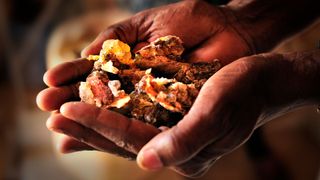What is frankincense?
Why is frankincense associated with Christmas and medical treatments?

Frankincense was one of the three gifts brought to the baby Jesus by the three wise men, according to the Gospel of Matthew. But what, exactly, is this Christmastime substance?
Frankincense is the dried sap of trees in the Boswellia genus. "There are about 50 species of these trees," said Ahmed Ali, an honorary research fellow at the University of Cardiff in the U.K. "Many of them grow in the Horn of Africa; one species grows in the Middle East, and another in India." When dried, the sap is burned as incense and thought to have several medicinal properties.
To gather frankincense, producers puncture the tree using a traditional chisel-like tool, after which a milky white sap leeches out of the hole, forming "tears." This tapping process is repeated multiple times at several points throughout the year, depending on the region. After the stonelike gobs are gathered, they are put out to dry.
About 2,000 years ago, frankincense was mainly prized for its use in religious ceremonies as incense, as most varieties have a woody, musky scent thanks to a group of chemicals in the resin called terpenes. At the time, thousands of tons were shipped from Africa around the Mediterranean, to India, and even as far as China, making frankincense one of the most lucrative commodities.
"Back then, Somali frankincense — Boswellia frereana — was the variety that was most traded," Ali told Live Science. "In Arabic, it's called Asli, which means 'the original' or 'the first,' and it's thought to be the one that was presented to Jesus."
Related: Why is Christmas celebrated on Dec. 25?
Each of the gifts the three wise men brought to the birth of Jesus is believed to have a symbolic meaning, the Bishop of St Asaph, the Right Reverend Gregory Cameron, told the BBC. Gold represents Christ's role as king; frankincense symbolizes deity; and myrrh, a sap-like resin that was used in embalming; represents death and links to his role as prophet.
In addition to its religious symbolism, frankincense has been recognized for its possible health benefits — most notably, anti-inflammatory properties — for thousands of years.
"In Vedic [ancient Indian] and Chinese herbal medicine, frankincense has been used to mitigate the symptoms of arthritis, chronic bronchitis, asthma and inflammatory bowel disease," Ali said. "It's actually also a very popular health supplement in the U.K., second only to turmeric. You'll often find 'turmeric plus boswellia' or 'Omega oils plus boswellia,' and that's actually Indian frankincense — Boswellia serrata."
The active ingredient in most frankincense varieties is a compound called boswellic acid, which is thought to inhibit several of the biochemical processes involved in inflammation and pain. But Somali frankincense is a little different, and this is the subject of Ali's research. "Somali frankincense is unique. It doesn't contain any boswellic acid. The main compound is a chemical called epilupeol," he said.
Epilupeol targets a protein called MMp-9, which is elevated in inflammatory-related diseases. By inhibiting this protein, epilupeol suppresses the body's pain and inflammation responses for hundreds of conditions.
"So far, in vitro [in a test tube] we've treated arthritis, inflammatory bowel disease, multiple sclerosis and metastatic cancer," Ali said. Ultimately, Ali hopes to develop this promising compound into a drug ready for clinical trials, but in the meantime, he's keen to spread the word about the medical benefits of frankincense.
"The two types, Somali and boswellic acid-containing — they're not in competition," he said. "They work in symbiosis, targeting different biochemical markers with different mechanisms of action, and that's really powerful."
Editor's note: This article was originally published on Dec. 24, 2012 and rewritten on Dec. 22, 2023.
Sign up for the Live Science daily newsletter now
Get the world’s most fascinating discoveries delivered straight to your inbox.

Victoria Atkinson is a freelance science journalist, specializing in chemistry and its interface with the natural and human-made worlds. Currently based in York (UK), she formerly worked as a science content developer at the University of Oxford, and later as a member of the Chemistry World editorial team. Since becoming a freelancer, Victoria has expanded her focus to explore topics from across the sciences and has also worked with Chemistry Review, Neon Squid Publishing and the Open University, amongst others. She has a DPhil in organic chemistry from the University of Oxford.
